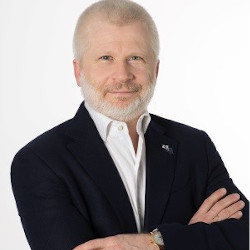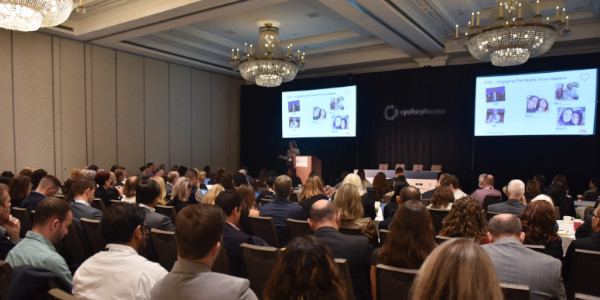Lode Dewulf is trusted as a global thought leader for patient engagement in medicine development. He currently works as Chief Patient Officer at Servier, a foundation-governed global pharmaceutical company.

Lode Dewulf, MD, DPM, FFPM, Chief Patient Affairs Officer, Servier
When Dr. Dewulf studied and practiced medicine, he quickly realized that true engagement, with the patients and their families, are at least as important as good medicine in achieving the best health outcomes. He joined the pharmaceutical industry in 1989 to create a broader impact through medical education. Ten years later, when the internet started to grow as a new way to provide quality medical information, he took a sabbatical and co-founded PlanetMedica, Europe’s first healthcare portal. Dr. Dewulf continued in global executive leadership roles in pharmaceutical medical affairs. In 2012 at UCB, he became Chief Patient Affairs Officer, the industry’s first executive dedicated to patient affairs. Dr. Dewulf volunteers his time supporting individual patients and advising both private and public organizations about patient engagement.
Emi: In what sense do you think the pharma industry does not yet know about patients?
Dewulf: In fact, industry does know about patients, as do healthcare professionals and many other scientists. The issue is that about is simply not enough.
Ancient Oriental wisdom already included the understanding that we learn on three levels: informational, related and through experience. On the first level we learn a lot of facts and information about a topic or a person. This is like most of us know a varying amount of data about a country like France. On the second level we add color and depth to the data and information (of level 1) by learning from someone who tells us what it is like. This is like listening to someone who has lived and worked in France; it will add a new dimension to what we know about the country. On the third level we gain a totally different level of understanding, by experiencing it for ourselves. That is like actually visiting France or going there to live and work for a while.
The insights gained by actually experiencing something yourself (i.e. level 3) are very different and profound. In addition, they are so very powerful that they can in fact change the interpretation of what we know from learning facts (i.e. level 1) and from listening to the experience of others (i.e. level 2). Just think of going to that special restaurant you had so much read about. Or what changed in your understanding when you actually became a parent, after previously only knowing other parents.
Physicians know about diseases because they learn facts about them (i.e. level 1) and because they listen to patients who are telling them about the impact of the disease and its treatments on them and on their lives. So, unless physicians themselves experience a disease themselves, they will always lack level 3 insight. Wise physicians know this and remain humble.
Industry has historically relied exclusively on scientists and physicians to understand diseases, to understand about patients. And that means industry has operated on level 1 insights only. As industry engages directly with patients to listen and learn directly from them what it is like to live with a disease, industry makes a huge step forward and moves to level 2. And since industry itself cannot ever be on level 3, it is essential that industry keeps asking and humbly learning. We need to move from learning about patients to learning directly from patients, just like we learn directly from physicians and scientists. We need both patients and physicians, because indeed their knowledge and thus the insights gained are complimentary, not exclusive or hierarchical.
To achieve this goal, we need to move from working ‘merely’ for patients (which describes our good intent) to working with patients (which describes how we act on our intent). At Servier, we call this ‘Patient In’: working with and for patients.
I believe that patient expertise can and should complement medical and scientific expertise. I advocate good listening as the starting point and see the digital revolution as an opportunity for all stakeholders in healthcare to better understand and work with each other.

Emi: At the 2019 EyeforPharma US Patient Summit, everyone seemed to agree that “patient engagement is tied to employee engagement.” In your experience, what critical actions are needed to drive this cultural change ethically, practicably and sustainably?
Dewulf: Patient Engagement is the systematic and meaningful collaboration that helps to develop and deliver better care to them. Patient Engagement is essential to reach common goals in healthcare, and especially those goals that are relevant and important to patients.
What is the cultural shift needed to achieve systemic and meaningful patient engagements all across healthcare? Historically, healthcare has always been ‘for’ patients, in that the intent was to serve patients as good as possible. But good intent is not enough; the ‘how’ also matters. And this is why our culture in healthcare needs to shift from ‘merely’ working FOR patients to working WITH patients, systematically and meaningfully.
Culture is the sum of what a group of people believe, think, do and pass on. So the new patient engagement culture we need is one where all healthcare stakeholders, including patients:
- Believe that working with patients is best and needed to create value;
- Think about ways how best work with patients;
- Do it: engage patients, using best practice to work with patients, systematically and meaningfully;
- Educate others about the above.
So, where to start? Again ancient wisdom is good guidance: just follow the Golden Rule. The Golden Rule, which has been shared across cultures and eras, is to ‘Treat others like you want to be treated’. That is a great start. How do you want to be treated? It appears there is huge commonality in how one wants to be treated as a child by a parent, as a pupil by a teacher, as an employee by a boss and as a patient by a physician. Common elements include:
- Listen to me. Take time. Really listen. Seek to understand, not to comment and certainly not to judge.
- See me as more than my role (i.e. as child, as pupil, as employee or as patient). For I am more than any and all of those roles. I am a person, with many dimensions and roles.
- Respect my values. Especially if we have different values. True respect means that we get along in spite of perhaps different values and goals. Help me to achieve mine.
- Decide with me, not for me. If a decision will affect me, then at least I should be asked and heard for my perspective. One famous slogan of the patient community for years has been “Nothing about me without me”.
- Be loyal. I may, and in fact will, disappoint you. Because I, like you, am human. Do not drop me, do not leave me. Especially when you think you have nothing left to give me, you still have you to give to me. Be with me till the end.
It is silly to expect employees to treat patients according to principles like these when those employees are not treated themselves according to those very same principles. If employees are treated merely as production and profitability units, to be replaced when possible by others with a higher ROI, how can those employees ever see and treat patients as anything else that a disposable source of data and/or revenues?
The Golden Rule “Treat others like you want to be treated’ really requires you treat yourself good first. This is why at Servier we take great care of our employees and of each other as employees. In other words, ‘Patient In’ starts with ‘people in’.
Emi: How can we be structured for patient engagement? I.e. What kind of structure, tools, and data will help manage patient engagement?
Dewulf: As the realization grows that and how much we need patient engagement, a lot of initiatives have started and are starting throughout the world of healthcare. Indeed, we see initiatives to further meaningful patients in many different countries and also by many stakeholders, from patients themselves to authorities, from hospitals to pharma, from providers to payers. The big issue is that most of these initiatives are isolated and disconnected. This represents a lot of effort for a very small overall and usually very local impact.
The defragmentation of the efforts to accelerate the move to a Culture of systematic and meaningful engagement in healthcare is therefore a top priority. And that requires all different stakeholders, all of us, to work together in new ways. Only together will we develop standards that will be accepted by all and thus can be used systematically. Such true partnering, with each other and with patients, is itself already a change in culture and structure.
In October 2015 a global coalition was set up to synergize between all able and willing parties to foster Patient Engagement in Medicine Development (PMFD). In just four years this collaborative approach has already led to important and essential progress in setting and openly sharing standards in several important aspects of patient engagement:
- A Book of Good Patient Engagement Practices
- An open source tool for sharing Patient Engagement initiatives
- A Patient Engagement Quality tool, for planning and/or assessment
- Principles for Reasonable Agreements between patients and pharma
- A global open-source training for Pharma staff on Patient Engagement
- Principles/tools for Fair Market Value compensation for patient work
All of these have been created with patients and with other stakeholders. For further information, see patientfocusedmedicine.org under the tab “Our projects”. Also, PMFD recently launched The Patient Engagement Industry Training.
So, the tools are increasingly available. A next question is how to internally organize, within a pharma company, or within a regulatory or provider organization. Here, they key advice is to not standardize. Indeed, in the same way as ‘one solution fits all’ does not work for patients, one same way of organizing does not work for every pharma company or other organization. Like patients, companies have different and unique histories, organizations and aspirations. As with patients, the first step is to understand the very specific needs and aspirations. The key is to work with the patient, so with the organization, to find out what will works best for them. The best medicine (scientifically speaking) is useless unless it can be applied and is in effect taken. The same is true for any organizational medicine. So, again the Golden Rule applies.
While the actual organization of/within a pharma company will (and should) differ, there are a few general remarks to be made:
- Firstly, the ultimate goal is to have (all) employees understand (the need for) patient engagement and (to varying degrees) work with patients. That means that “exclusivity” of this understanding or practice in a specific team or part of the organization cannot be the long term goal or structure, even though it may be the most efficient way to get started, or for specific parts of the task.
- Secondly, the actual organization will (need to) evolve over time but must always ensure continuity in the relationship with the patients and patient groups engaged. Patients and patient groups are partners, and the engagement with them should be relational, not just transactional.
- Thirdly, it is very important to connect the inside of the pharma company (i.e. whoever engages with patients) with the outside: the patients and patient groups, obviously, but also the other stakeholders and especially to collaborative efforts that aim to continue rising standards in Patient Engagement.
At Servier, we have chosen for a small team of Corporate Patient Affairs who actively work with our colleagues through the organization to apply our Patient In strategy. We are helped by Ambassadors, our Patient In Culture vectors, and our Referents, our Patient In experts.
Emi: Could you tell us any pharma-initiated best practices of patient engagement that have been well received.
Dewulf: I advocate for collaborative efforts to create and spread best patient engagement practices. That always begins with a well-informed, ideally joint decision with patients.
Many companies today are engaging with patients very well in specific areas or for specific projects. The best way to share such good examples is to put them all in one single open-access place, and such a place now exists: synapse.pfmd.org
As above, the PFMD (Patient Focused Medicines Development) coalition continues to co-create standards and tools to accelerate the cultural shift toward systematic and meaningful patient engagement. Other collaborative efforts also exist: a few examples:
- PARADIGM, a project of the EU Innovative Medicines Initiative (IMI), the largest public-private partnership in health in the world.
- In the US, groups like the National Health Council, the Clinical Trials Transformation Initiative and Faster Cures all bring together multiple stakeholders to work on common standards and solutions.
- In China, activities are also starting as part of the government’s strong commitment to improve healthcare. For example, a first congress on Patient Centricity in December 2019 will bring together multiple stakeholders to accelerate the improvement of healthcare through patient centric collaboration.
Servier is proud to work with several of these initiatives to advance the Patient Centric Culture and practices around the world.





